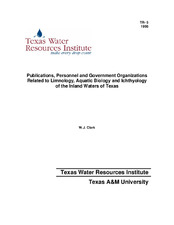| dc.description.abstract | This report is the result of a growing concern about the rate at which development of the water resources of Texas is outstripping biological and ecological knowledge of the aquatic environments concerned.
Most Texas streams are already much modified by present impoundments, diversions, and pollution. The magnitude of proposed future development is evidenced by planning proposals published in 1961 by the Texas Board of Water Engineers (1) and in 1966 by its successor agency, the Texas Water Development Board (2).
Although municipal, industrial, and agricultural water requirements currently have a preeminent role in planning water development, recreational considerations are becoming increasingly important. Factors which influence the quality and quantity of the aquatic biota have a profound effect on recreational potential, as well as on water quality aspects of other water uses.
Thus far water resource development in Texas has proceeded with little information available on possible biological effects, and only general predictions can be made based on experience elsewhere. If data are going to be available which will enable effective consideration of biological problems to be made in the planning stages of water development projects, there must be sizable increases in the quantity and quality of aquatic research.
The taxonomy and distribution of fresh water fishes in Texas are well known, but ecological data are scarce. Our knowledge of the taxonomy, distribution and ecology of other aquatic organisms in Texas is rudimentary. Baseline information giving data on stream populations prior to development modification is meager, in contrast to the abundant physical and chemical data provided by the United States Geological Survey, the Texas Water Development Board and other agencies. Additional research is still needed on many physical and chemical problems, however.
The compilation contained herein has two objectives: (1) to be of assistance to those already working in the fields covered and (2) to provide a status report which may encourage and perhaps make easier the entry of new researchers into these fields.
Primary emphasis has been placed on compiling the bibliographic material and on the personnel roster. The data on state and federal agencies and on courses offered at colleges and universities became available in the course of the investigation and has been included primarily to assist those new to the field in becoming oriented. | en |


